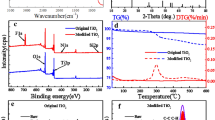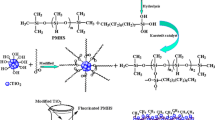Abstract
Surface wetting is an important and relevant phenomenon in several different fields. Scientists have introduced a large number of applications where special surface wetting could be exploited. Here, we study wetting phenomena on high- and low-adhesive superhydrophobic liquid flame spray (LFS)-generated TiO2 coatings on paper and pigment-coated board substrates using water–ethanol solution as a probe liquid. Submicrometer-scale air gaps, which exist on superhydrophobic surfaces below the liquid droplets, were more stable with the ethanol increment than the larger-scale micrometric air gaps. With the droplet ethanol concentration of 15 wt%, static contact angle as high as 155 ± 2° was measured on the LFS–TiO2-coated board. Transition from the low-adhesive wetting state to the high-adhesive state was demonstrated on the LFS–TiO2-coated paper. The LFS method enables efficient roll-to-roll production of surfaces with special wetting properties on economically viable board and paper substrate materials.






Similar content being viewed by others
References
Koch K, Bhushan B, Barthlott W (2009) Multifunctional surface structures of plants: an inspiration for biomimetics. Prog Mater Sci 54:137–178
Liu M, Zheng Y, Zhai J, Jiang L (2010) Bioinspired super-antiwetting interfaces with special liquid─solid adhesion. Acc Chem Res 43:368–377
Byun D, Hong J, Saputra KJH, Lee YJ, Park HC, Byun B-K, Lukes JR (2009) Wetting characteristics of insect wing surfaces. J Bionic Eng 6:63–70
Barthlott W, Neinhuis C (1997) Purity of the sacred lotus, or escape from contamination in biological surfaces. Planta 202:1–8
Zheng Y, Gao X, Jiang L (2007) Directional adhesion of superhydrophobic butterfly wings. Soft Matter 3:178–182
Fang Y, Sun G, Cong Q, G-h C, L-q R (2008) Effects of methanol on wettability of the non-smooth surface on butterfly wing. J Bionic Eng 5:127–133
Gao X, Jiang L (2004) Water-repellent legs of water striders. Nature 432:36
Feng L, Zhang Y, Xi J, Zhu Y, Wang N, Xia F, Jiang L (2008) Petal effect: a superhydrophobic state with high adhesive force. Langmuir 24:4114–4119
Teisala H, Tuominen M, Kuusipalo J (2011) Adhesion mechanism of water droplets on hierarchically rough superhydrophobic rose petal surface. J Nanomater. doi:10.1155/2011/818707
Kuusipalo J (2008) Paper and paperboard converting, 2nd edn. Paperi ja Puu Oy, Jyväskylä
Bhushan B, Jung YC, Koch K (2009) Self-cleaning efficiency of artificial superhydrophobic surfaces. Langmuir 25:3240–3248
Fujishima A, Rao TN, Tryk DA (2000) Titanium dioxide photocatalysis. J Photochem Photobiol C: Photochem Rev 1:1–21
Schmidt H (1994) Multifunctional inorganic─organic composite sol─gel coatings for glass surfaces. J Non-Cryst Solids 178:302–312
Ahn CH, Choi J-W, Beaucage G, Nevin JH, Lee J-B, Puntambekar A, Lee JY (2004) Disposable smart lab on a chip for point-of-care clinical diagnostics. Proc IEEE 92:154–173
Londe G, Chunder A, Wesser A, Zhai L, Cho HJ (2008) Microfluidic valves based on superhydrophobic nanostructures and switchable thermosensitive surface for lab-on-a-chip (LOC) systems. Sensors Actuators, B 132:431–438
Ma M, Hill RM (2006) Superhydrophobic surfaces. Curr Opin Colloid Interface Sci 11:193–202
Roach P, Shirtcliffe NJ, Newton MI (2008) Progress in superhydrophobic surface development. Soft Matter 4:224–240
Carré A, Mittal KL (2009) Superhydrophobic surfaces. VSP/Brill, Leiden
Wenzel RN (1936) Resistance of solid surfaces to wetting by water. Ind Eng Chem 28:988–994
Cassie ABD, Baxter S (1944) Wettability of porous surfaces. Trans Faraday Soc 40:546–551
Quéré D (2008) Wetting and roughness. Annu Rev Mater Res 38:71–99
Kulinich SA, Farzaneh M (2009) Effect of contact angle hysteresis on water droplet evaporation from super-hydrophobic surfaces. Appl Surf Sci 255:4056–4060
Teisala H, Tuominen M, Aromaa M, Stepien M, Mäkelä JM, Saarinen JJ, Toivakka M, Kuusipalo J (2012) Nanostructures increase water droplet adhesion on hierarchically rough superhydrophobic surfaces. Langmuir 28:3138–3145. doi:10.1021/la203155d
Balu B, Berry AD, Hess DW, Breedveld V (2009) Patterning of superhydrophobic paper to control the mobility of micro-liter drops for two-dimensional lab-on-paper applications. Lab Chip 9:3066–3075
Nyström D, Lindqvist J, Östmark E, Hult A, Malmström E (2006) Superhydrophobic bio-fibre surfaces via tailored grafting architecture. Chem Commun 34:3594─3596
Li S, Zhang S, Wang X (2008) Fabrication of superhydrophobic cellulose-based materials through a solution-immersion process. Langmuir 24:5585–5590
Balu B, Breedveld V, Hess DW (2008) Fabrication of “roll-off” and “sticky” superhydrophobic cellulose surfaces via plasma processing. Langmuir 24:4785–4790
Yang H, Deng Y (2008) Preparation and physical properties of superhydrophobic papers. J Colloid Interface Sci 325:588–593
Balu B, Kim JS, Breedveld V, Hess DW (2009) Tunability of the adhesion of water drops on a superhydrophobic paper surface via selective plasma etching. J Adhesion Sci Technol 23:361–380
Quan C, Werner O, Wågberg L, Turner C (2009) Generation of superhydrophobic paper surfaces by a rapidly expanding supercritical carbon dioxide-alkyl ketene dimer solution. J Supercrit Fluids 49:117–124
Werner O, Quan C, Turner C, Pettersson B, Wågberg L (2010) Properties of superhydrophobic paper treated with rapid expansion of supercritical CO2 containing a crystallizing wax. Cellulose 17:187–198
Wang S, Li M, Lu Q (2010) Filter paper with selective absorption and separation of liquids that differ in surface tension. ACS Appl Mater Interfaces 2:677–683
Tikkanen J, Gross KA, Berndt CC, Pitkänen V, Keskinen J, Raghu S, Rajala M, Karthikeyan J (1997) Characteristics of the liquid flame spray process. Surf Coat Technol 90:210–216
Aromaa M, Keskinen H, Mäkelä JM (2007) The effect of process parameters on the liquid flame spray generated titania nanoparticles. Biomol Eng 24:543–548
Teisala H, Tuominen M, Aromaa M, Mäkelä JM, Stepien M, Saarinen JJ, Toivakka M, Kuusipalo J (2010) Development of superhydrophobic coating on paperboard surface using the liquid flame spray. Surf Coat Technol 205:436–445
Teisala H, Tuominen M, Aromaa M, Stepien M, Mäkelä JM, Saarinen JJ, Toivakka M, Kuusipalo J (2012) Nanoparticle deposition on packaging materials by liquid flame spray ─generation of superhydrophilic and superhydrophobic coatings. In: Proceedings of the Special Symposium on Recent Advances in Adhesion Science and Technology, 240th ACS National Meeting, August 22–26, 2010, Boston, Accepted.
Stepien M, Saarinen JJ, Teisala H, Tuominen M, Aromaa M, Kuusipalo J, Mäkelä JM, Toivakka M (2011) Adjustable wettability of paperboard by liquid flame spray nanoparticle deposition. Appl Surf Sci 257:1911–1917
Mäkelä JM, Aromaa M, Teisala H, Tuominen M, Stepien M, Saarinen JJ, Toivakka M, Kuusipalo J (2011) Nanoparticle deposition from liquid flame spray onto moving roll-to-roll paperboard material. Aerosol Sci Technol 45:827–837
Tuominen M, Teisala H, Aromaa M, Stepien M, Mäkelä JM, Saarinen JJ, Toivakka M, Kuusipalo J (2012) Creation of superhydrophilic surfaces of paper and board. J Adhesion Sci Technol. doi:10.1080/01694243.2012.697744
Vázquez G, Alvarez E, Navaza JM (1995) Surface tension of alcohol + water from 20 to 50 °C. J Chem Eng Data 40:611–614
Jung YC, Bhushan B (2007) Wetting transition of water droplets on superhydrophobic patterned surfaces. Scr Mater 57:1057–1060
Varanasi KK, Deng T, Hsu MF, Bhate N (2009) Wetting hysteresis, metastability, and droplet impact on superhydrophobic surfaces. In: Proceedings of IPACK2009, InterPACK´09, 2009, San Francisco, California, USA
Callies M, Quéré D (2005) On water repellency. Soft Matter 1:55–61
Boreyko JB, Baker CH, Poley CR, Chen C-H (2011) Wetting and dewetting transitions on hierarchical superhydrophobic surfaces. Langmuir 27:7502–7509
Acknowledgments
Tekes (Finnish Funding Agency for Technology and Innovation) is acknowledged for the financial support of this study. The work was carried out in the Functional Materials 2007–2013 program, under the project called Liquid Flame Spray nanocoating for flexible roll-to-roll web materials.
Author information
Authors and Affiliations
Corresponding author
Additional information
This article is part of the Topical Collection on Contact Angle Hysteresis.
Rights and permissions
About this article
Cite this article
Teisala, H., Tuominen, M., Aromaa, M. et al. High- and low-adhesive superhydrophobicity on the liquid flame spray-coated board and paper: structural effects on surface wetting and transition between the low- and high-adhesive states. Colloid Polym Sci 291, 447–455 (2013). https://doi.org/10.1007/s00396-012-2833-5
Received:
Accepted:
Published:
Issue Date:
DOI: https://doi.org/10.1007/s00396-012-2833-5




